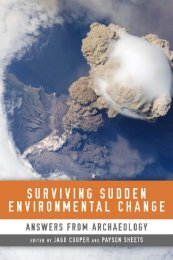Utatlan: The Constituted Community of the K'iche Maya of Q'umarkaj
Utatlan: The Constituted Community of the K'iche Maya of Q'umarkaj
Utatlan: The Constituted Community of the K'iche Maya of Q'umarkaj
You also want an ePaper? Increase the reach of your titles
YUMPU automatically turns print PDFs into web optimized ePapers that Google loves.
<strong>The</strong> Greater Utatlán Project<br />
(1991: 15). Fur<strong>the</strong>r, this is a community because <strong>of</strong> a deeply held feeling <strong>of</strong> comradeship,<br />
irrespective <strong>of</strong> class differences, that has motivated members <strong>of</strong> nations to<br />
willingly die for this imagined entity (Anderson 1991: 16).<br />
Canuto and Fash (2004) elaborate on <strong>the</strong> difference between what <strong>the</strong>y call a<br />
natural community and a constituted community. <strong>The</strong>y consider <strong>the</strong> former to be a<br />
static social entity that is tied to a location or place in isolation, and natural community<br />
does not take into account <strong>the</strong> range <strong>of</strong> external interactions in which its<br />
members engage. <strong>The</strong> natural community is visible in <strong>the</strong> spatial boundaries, <strong>the</strong><br />
residential nucleation, and <strong>the</strong> shared material culture (Canuto and Fash 2004: 55–<br />
56). <strong>The</strong> constituted community, however, is less a place and more an idea independent<br />
<strong>of</strong> place. An analogy is made with <strong>the</strong> Jewish Diaspora or with ethnic enclaves<br />
in foreign cities, who maintain a sense <strong>of</strong> identity that is related to <strong>the</strong>ir imagined<br />
community ra<strong>the</strong>r than <strong>the</strong>ir physical residence (Canuto and Fash 2004: 57).<br />
<strong>The</strong> community can be addressed methodologically in archaeological interpretation.<br />
One should consider <strong>the</strong> concept as multilayered. <strong>The</strong>re are spatial correlates<br />
in understanding community but <strong>the</strong> nature <strong>of</strong> human interactions is central to <strong>the</strong><br />
interpretive framework. “<strong>The</strong> community is not a spatial cluster <strong>of</strong> material remains<br />
to be observed, but ra<strong>the</strong>r a social process to be inferred” (Yaeger and Canuto 2000:<br />
9). Not all have adopted this approach. <strong>The</strong> study <strong>of</strong> archaeological communities<br />
as it developed in <strong>the</strong> first half <strong>of</strong> <strong>the</strong> twentieth century defined <strong>the</strong> community as<br />
“directly interacting individuals—fulfilling its own social, economic, and reproductive<br />
needs,” but <strong>the</strong> science <strong>of</strong> anthropology grew to understand <strong>the</strong> community as<br />
“<strong>the</strong> natural unit <strong>of</strong> human organization within which <strong>the</strong> linkage <strong>of</strong> society and<br />
culture could be explained” (Isbell 2000: 245).<br />
<strong>The</strong> sense <strong>of</strong> community is ambiguous. It can be described in terms <strong>of</strong> shared<br />
space or as shared experience, goals, sentiments, and knowledge. It can be described<br />
etically, as observable by an external investigator, or emically, as experienced by<br />
<strong>the</strong> members (Isbell 2000: 243). At <strong>the</strong> outset <strong>of</strong> this project it was unclear what<br />
arguments <strong>the</strong> data would support. Would we recover materials that would permit<br />
only an external observer’s estimation <strong>of</strong> <strong>the</strong> spatial extent <strong>of</strong> <strong>the</strong> Greater Utatlán<br />
residence zone and its internal complexity as evidenced by social stratification, craft<br />
specialization, architectural variations, and artifact inventory? Or would <strong>the</strong>re be<br />
recoverable data that could permit this observer, more than 400 years after <strong>the</strong><br />
abandonment <strong>of</strong> <strong>the</strong> site, to understand how <strong>the</strong> residents were able to link toge<strong>the</strong>r<br />
<strong>the</strong> subunits <strong>of</strong> this space and self-identify as members <strong>of</strong> <strong>the</strong> Utatlán community?<br />
This is not meant to discount <strong>the</strong> arguments by Monica Smith (2003) that <strong>the</strong><br />
relationships among city residents with <strong>the</strong>ir rural associates integrate <strong>the</strong> functional<br />
aspects <strong>of</strong> urbanism with <strong>the</strong> world outside and blur <strong>the</strong> boundaries between urban<br />
and rural, or city and hinterlands. When she writes, “Formal recognized boundaries<br />
are likely to result from specific requirements imposed by political entities . . . nor<br />
25





